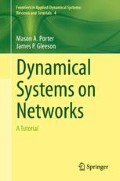Abstract
For simplicity, we frame our discussions in terms of unweighted, undirected networks. When such a network is time-independent, it can be represented using a symmetric adjacency matrix A = A T with elements \(A_{ij} = A_{ji}\) that are equal to 1 if nodes i and j are connected (or, more properly, “adjacent”) and 0 if they are not.
Access this chapter
Tax calculation will be finalised at checkout
Purchases are for personal use only
Notes
- 1.
This is a standard assumption, but it is not always desirable. For example, one may wish to investigate narcissism in people tagging themselves in pictures on Facebook, a set of coupled oscillators can include self-interactions, and so on.
- 2.
By analogy with statistical physics, the N → ∞ limit is often called a “thermodynamic limit.”
- 3.
Reference [212] gives one illustration of how considering a very unrealistic random-graph ensemble can be crucial for developing understanding of the behavior of a dynamical process on networks.
- 4.
Strictly speaking, one also needs to ensure appropriate conditions on the moments of P k as N → ∞. For example, one could demand that the second moment remains finite as N → ∞.
References
A.L. Barabási, R. Albert, Emergence of scaling in random networks. Science 286(5439), 509–512 (1999)
K.E. Bassler, C.I. Del Genio, P. Erdős, I. Miklós, Z. Toroczkai, Exact sampling of graphs with prescribed degree correlations. New J. Phys. 17(8), 083052 (2015)
B. Bollobás, Random Graphs, 2nd edn. (Cambridge University Press, Cambridge, 2011)
A. Clauset, C.R. Shalizi, M.E.J. Newman, Power-law distributions in empirical data. SIAM Rev. 51(4), 661–703 (2009)
P. Csermely, A. London, L.-Y. Wu, B. Uzzi, Structure and dynamics of core–periphery networks. J. Complex Networks 1(2), 93–123 (2013)
D.J. de Solla Price, A general theory of bibliometric and other cumulative advantage processes. J. Am. Soc. Inf. Sci. 27(5), 292–306 (1976)
A. Hackett, J.P. Gleeson, Cascades on clique-based graphs. Phys. Rev. E 87(6), 062801 (2013)
S. Melnik, J.A. Ward, J.P. Gleeson, M.A. Porter, Multi-stage complex contagions. Chaos 23(1), 013124 (2013)
S. Melnik, M.A. Porter, P.J. Mucha, J.P. Gleeson, Dynamics on modular networks with heterogeneous correlations. Chaos 24(2), 023106 (2014)
J.C. Miller, Complex contagions and hybrid phase transitions. J. Complex Networks (2015). doi: 10.1093/comnet/cnv021
M.E.J. Newman, Networks: An Introduction (Oxford University Press, Oxford, 2010)
M.A. Porter, J.-P. Onnela, P.J. Mucha, Communities in networks. Not. Am. Math. Soc. 56(9), 1082–1097 1164–1166 (2009)
M.P.H. Stumpf, M.A. Porter, Critical truths about power laws. Science 51(6069), 665–666 (2012)
Author information
Authors and Affiliations
Rights and permissions
Copyright information
© 2016 Springer International Publishing Switzerland
About this chapter
Cite this chapter
Porter, M.A., Gleeson, J.P. (2016). A Few Basic Concepts. In: Dynamical Systems on Networks. Frontiers in Applied Dynamical Systems: Reviews and Tutorials, vol 4. Springer, Cham. https://doi.org/10.1007/978-3-319-26641-1_2
Download citation
DOI: https://doi.org/10.1007/978-3-319-26641-1_2
Published:
Publisher Name: Springer, Cham
Print ISBN: 978-3-319-26640-4
Online ISBN: 978-3-319-26641-1
eBook Packages: Mathematics and StatisticsMathematics and Statistics (R0)

